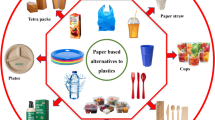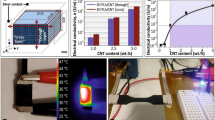Abstract
Novel polymeric active food packaging films comprising halloysite nanotubes (HNTs) as active agents were developed. HNTs which are hollow tubular clay nanoparticles were utilized as nanofillers absorbing the naturally produced ethylene gas that causes softening and aging of fruits and vegetables; at the same time, limiting the migration of spoilage-inducing gas molecules within the polymer matrix. HNT/polyethylene (HNT/PE) nanocomposite films demonstrated larger ethylene scavenging capacity and lower oxygen and water vapor transmission rates than neat PE films. Nanocomposite films were shown to slow down the ripening process of bananas and retain the firmness of tomatoes due to their ethylene scavenging properties. Furthermore, nanocomposite films also slowed down the weight loss of strawberries and aerobic bacterial growth on chicken surfaces due to their water vapor and oxygen barrier properties. HNT/PE nanocomposite films demonstrated here can greatly contribute to food safety as active food packaging materials that can improve the quality and shelf life of fresh food products.







Similar content being viewed by others
References
Abeles, F. B., Morgan, P. W., & Saltveit, M. E. (1992). Ethylene in plant biology. Academic Press.
Ahmadi, S. J., Huang, Y., & Li, W. (2005). Fabrication and physical properties of EPDM–organoclay nanocomposites. Composites Science and Technology, 65(7–8), 1069–1076.
Alexandre, M., & Dubois, P. (2000). Polymer-layered silicate nanocomposites: preparation, properties and uses of a new class of materials. Materials Science and Engineering: R: Reports, 28(1–2), 1–63.
Alexandre, B., Langevin, D., Médéric, P., Aubry, T., Couderc, H., Nguyen, Q. T., et al. (2009). Water barrier properties of polyamide 12/montmorillonite nanocomposite membranes: structure and volume fraction effects. Journal of Membrane Science, 328(1–2), 186–204.
Brody, A. L., Strupinsky, E. P., & Kline, L. R. (2001). Active packaging for food applications.
Choudalakis, G., & Gotsis, A. D. (2009). Permeability of polymer/clay nanocomposites: a review. European Polymer Journal, 45(4), 967–984.
Cui, L., Cho, H. Y., Shin, J.-W., Tarte, N. H., & Woo, S. I. (2007). Polyethylene-montmorillonite nanocomposites: preparation, characterization and properties. Macromolecular Symposia, 260(1), 49–57.
Cui, Y., Kumar, S., Rao Kona, B., & van Houcke, D. (2015). Gas barrier properties of polymer/clay nanocomposites. RSC Advances, 5(78), 63669–63690.
Du, M., Guo, B., & Jia, D. (2006a). Thermal stability and flame retardant effects of halloysite nanotubes on poly(propylene). European Polymer Journal, 42(6), 1362–1369.
Du, M., Guo, B., Liu, M., & Jia, D. (2006b). Preparation and characterization of polypropylene grafted halloysite and their compatibility effect to polypropylene/halloysite composite. Polymer Journal, 38(11), 1198–1204.
Forsgren, J., Jämstorp, E., Bredenberg, S., Engqvist, H., & Strømme, M. (2010). A ceramic drug delivery vehicle for oral administration of highly potent opioids. Journal of Pharmaceutical Sciences, 99(1), 219–226.
Gorrasi, G., Tortora, M., Vittoria, V., Pollet, E., Lepoittevin, B., Alexandre, M., & Dubois, P. (2003). Vapor barrier properties of polycaprolactone montmorillonite nanocomposites: effect of clay dispersion. Polymer, 44(8), 2271–2279.
Handge, U. A., Hedicke-Höchstötter, K., & Altstädt, V. (2010). Composites of polyamide 6 and silicate nanotubes of the mineral halloysite: influence of molecular weight on thermal, mechanical and rheological properties. Polymer, 51(12), 2690–2699.
Jia, Z., Luo, Y., Guo, B., Yang, B., Du, M., & Jia, D. (2009). Reinforcing and flame-retardant effects of halloysite nanotubes on LLDPE. Polymer-Plastics Technology and Engineering, 48(6), 607–613.
Joshi, A., Abdullayev, E., Vasiliev, A., Volkova, O., & Lvov, Y. (2013). Interfacial modification of clay nanotubes for the sustained release of corrosion inhibitors. Langmuir: the ACS Journal of Surfaces and Colloids, 29(24), 7439–7448.
Lecouvet, B., Sclavons, M., Bourbigot, S., Devaux, J., & Bailly, C. (2011). Water-assisted extrusion as a novel processing route to prepare polypropylene/halloysite nanotube nanocomposites: structure and properties. Polymer, 52(19), 4284–4295.
Liu, M., Guo, B., Du, M., Chen, F., & Jia, D. (2009). Halloysite nanotubes as a novel β-nucleating agent for isotactic polypropylene. Polymer, 50(13), 3022–3030.
Liu, M., Jia, Z., Jia, D., & Zhou, C. (2014). Recent advance in research on halloysite nanotubes-polymer nanocomposite. Progress in Polymer Science, 39(8), 1498–1525.
Lvov, Y. M., DeVilliers, M. M., & Fakhrullin, R. F. (2016). The application of halloysite tubule nanoclay in drug delivery. Expert Opinion on Drug Delivery, 1–10
Marcilla, A., Gómez, A., Menargues, S., & Ruiz, R. (2005). Pyrolysis of polymers in the presence of a commercial clay. Polymer Degradation and Stability, 88(3), 456–460.
Morawiec, J., Pawlak, A., Slouf, M., Galeski, A., Piorkowska, E., & Krasnikowa, N. (2005). Preparation and properties of compatibilized LDPE/organo-modified montmorillonite nanocomposites. European Polymer Journal, 41(5), 1115–1122.
Owoseni, O., Nyankson, E., Zhang, Y., Adams, S. J., He, J., McPherson, G. L., et al. (2014). Release of surfactant cargo from interfacially-active halloysite clay nanotubes for oil spill remediation. Langmuir, 30(45), 13533–13541.
Ozdemir, M., & Floros, J. D. (2004). Active food packaging technologies. Critical Reviews in Food Science and Nutrition, 44(3), 185–193.
P.M., V., & Morlanes, M. J. M. (2015). Polyethylene-based blends, composites and nanocomposities. Wiley.
Pedrazzoli, D., Pegoretti, A., Thomann, R., Kristóf, J., & Karger-Kocsis, J. (2015). Toughening linear low-density polyethylene with halloysite nanotubes. Polymer Composites, 36(5), 869–883.
Picard, E., Vermogen, A., Gerard, J., & Espuche, E. (2007). Barrier properties of nylon 6-montmorillonite nanocomposite membranes prepared by melt blending: influence of the clay content and dispersion state, consequences on modelling. Journal of Membrane Science, 292(1–2), 133–144.
Prashantha, K., Lacrampe, M. F., & Krawczak, P. (2011). Processing and characterization of halloysite nanotubes filled polypropylene nanocomposites based on a masterbatch route: effect of halloysites treatment on structural and mechanical properties. Express Polymer Letters, 5(4), 295–307.
Rooney, M. L. (Ed.). (1995). Active food packaging. Boston, MA: Springer US.
Saltveit, M. E. (1999). Effect of ethylene on quality of fresh fruits and vegetables. Postharvest Biology and Technology, 15(3), 279–292.
Shemesh, R., Krepker, M., Natan, M., Danin-Poleg, Y., Banin, E., Kashi, Y., et al. (2015). Novel LDPE/halloysite nanotube films with sustained carvacrol release for broad-spectrum antimicrobial activity. RSC Advances, 5(106), 87108–87117.
Singh, V. P., Vimal, K. K., Kapur, G. S., Sharma, S., & Choudhary, V. (2016). High-density polyethylene/halloysite nanocomposites: morphology and rheological behaviour under extensional and shear flow. Journal of Polymer Research, 23(3), 43.
Srithammaraj, K., Magaraphan, R., & Manuspiya, H. (2012). Modified porous clay heterostructures by organic-inorganic hybrids for nanocomposite ethylene scavenging/sensor packaging film. Packaging Technology and Science, 25(2), 63–72.
Terry, L. A., Ilkenhans, T., Poulston, S., Rowsell, L., & Smith, A. W. J. (2007). Development of new palladium-promoted ethylene scavenger. Postharvest Biology and Technology, 45(2), 214–220.
Tully, J., Fakhrullin, R., & Lvov, Y. (2015). Halloysite clay nanotube composites with sustained release of chemicals (pp. 87–118). Netherlands: Springer.
Vergaro, V., Lvov, Y. M., & Leporatti, S. (2012). Halloysite clay nanotubes for resveratrol delivery to cancer cells. Macromolecular Bioscience, 12(9), 1265–1271.
Ward, C. J., Song, S., & Davis, E. W. (2010). Controlled release of tetracycline-HCl from halloysite-polymer composite films. Journal of Nanoscience and Nanotechnology, 10(10), 6641–6649.
Wills, R. B. H., & Warton, M. A. (2004). Efficacy of potassium permanganate impregnated into alumina beads to reduce atmospheric ethylene. J. Amer. Soc. Hort. Sci., 129(3), 433–438.
Wunderlich, B., & Czornyj, G. (1977). A study of equilibrium melting of polyethylene. Macromolecules, 10(5), 906–913.
Zhao, S., Cai, Z., & Xin, Z. (2008). A highly active novel β-nucleating agent for isotactic polypropylene. Polymer, 49(11), 2745–2754.
Acknowledgements
The authors thank Eczacıbaşı ESAN (Turkey) for providing HNTs, Mr. Turgay Gonul for assistance with SEM and TEM analyses, and Dr. Ilhan Ozen for assistance with gas permeability measurements. This work was supported by the Scientific and Technological Research Council of Turkey (TUBITAK; grant no. 113O872).
Author information
Authors and Affiliations
Corresponding author
Rights and permissions
About this article
Cite this article
Tas, C.E., Hendessi, S., Baysal, M. et al. Halloysite Nanotubes/Polyethylene Nanocomposites for Active Food Packaging Materials with Ethylene Scavenging and Gas Barrier Properties. Food Bioprocess Technol 10, 789–798 (2017). https://doi.org/10.1007/s11947-017-1860-0
Received:
Accepted:
Published:
Issue Date:
DOI: https://doi.org/10.1007/s11947-017-1860-0




